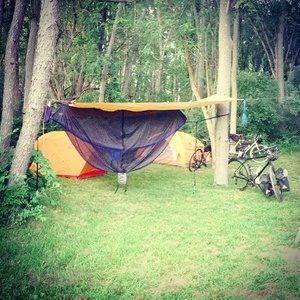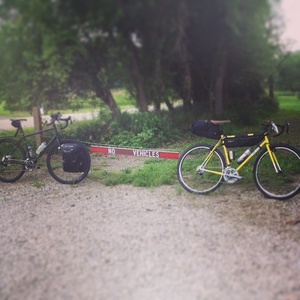With a great cycling infrastructure and camping just outside of town, Bloomington-Normal holds a perfect spot for bikepacking. Bikepacking is an adventure joining cycling and camping together in the great outdoors. It’s different from touring because you aren’t in for a long journey, but more of a memorable couple of days in complete wilderness. If you have ever wanted to merge these two hobbies to find a new incredible experience, look no further! This page is created to guide you through everything you are going to need to know about bikepacking. You will get a run through of gear, route decisions, food and tips of all things bikepacking. Take a look at pages like Outdoor Activities and Comlara Park to get a better idea of what the town has to offer for this great hobby. This guide could be the start of your next adventure!
Think of your favorite food. After you have that delicious picture of your mouths truest love, take a moment and think about your beverage of choice. Your mind is probably running on overload as you picture what might be the best tag team in history. Now image yourself taking the first bite and sip of those two favorites, and then again, and again. Now that I have your senses up to the correct level, let me introduce you to a hobby that is equal to what you just envisioned. Bikepacking has started coming alive over the past couple of years and it’s one of the best ways you can get out and explore the outdoors around you in a new light.
What is bikepacking you ask?
Bikepacking is the marriage of camping and cycling. You head out on your bicycle with everything that you will need for the day or next couple of days, and end at a new or favorite campsite. Most people instantly think that bikepacking is a form of touring, which is both true and untrue. Bikepacking is about good times around a campfire with friends, riding bikes and exploring new terrain, and living for the “now” moments during the journey. Touring is usually about getting from A to B, and though the journey is a big part of that story as well, it’s usually centered on the idea of traveling to an end place. Bikepacking makes the rider become completely self-sufficient from the gear that they carry to route they decide to use to get to their campsite, but keeps the focus on outdoors and escaping all town familiarities. Its outdoor focus allows you to take in the peacefulness of nature and slow the pace of your day to day.
The best local spot to bikepack to would definitely be Comlara Park. It’s about 15 miles outside of Bloomington-Normal, and the ride tends to be fairly flat with little to no challenges in directions. However, you are able to create different routes to give you more scenic and rural riding while extending some miles in the total distance of the trip. The biggest problem with bikepacking is obtaining gear for both hobbies. Both cycling and camping can get expensive fast, but with the right guides and information you can definitely get by without dropping big coin on the trip. It’s also different because the idea is centered on minimalist travel and packing light, light, light! You definitely want the perfect balance between sleeping comfortably and carrying a mattress on your bicycle.
The gear used in bikepacking can be purchased at specialty stores and/or at common shops in town. The first step would be making sure you have a bicycle adequate for the trip. Most riders choose between a mountain bike and a cyclocross/gravel bike of some kind. These two types of bikes are most popular because they are versatile on both road and off road paths, and they usually come with the ability to install things like bike luggage racks and bike soft packs. It’s recommended that you visit a bicycle shop like Bloomington Cycle to make sure your bike is capable for a trip like this before heading out on the open road.
GEAR:
On to the nitty gritty! Obtaining a bicycle that can make a trip like this is crucial, but the gear you use on the ride is just as essential. Creating a list of items is one of the biggest helps in the process of getting gear together. As you make a list of essentials, remember that packing light is key. The list should include the major items like: food, water, shelter and storage. Then look from those bigger block points to elaborate on making them become a reality in the outdoors and able to be mounted on a bicycle.
The examples used are from my overnight bikepacking trip this past summer, and the preparations I made to go on my adventure. I rode to Comlara Park with three of my friends to have an overnight bikepacking trip. We took a rural route to get in a 20 mile one way ride to our campsite. We stayed in the primitive campsite section because we wanted to experience real disconnect. The best part of Comlara Park is the two different camping options they offer. One is primitive, with no running water or bathroom/shower rooms. The normal campgrounds have electric plugins, bathrooms and running water. This park allows you to dictate the exact experience you want, and not compromise any of your must haves in camping.
Food - Should be able to pack 3 meals per day, for each day you are gone. They should be light and use minimal preparation and contain fuel (good fats, sugars and protein) to provide your body energy and recovery from the ride to the destination.
I packed: Energy bars (breakfast), beef jerky (snacking), soup (lunch), coffee, and beans and hot dogs (dinner).
To prep the food, I use compact camping cooking supplies. A Pocket Rocket stove, fire cubes to heat items and portable all-in-one dinning wear, along with using my coffee cup as a bowl helped keep my load light for the trip. Carrying a small soft lunch cooler with a portable ice pack can keep meat cool for an overnight trip. Making a fire along with cooking stoves is important because it becomes a fail safe for any cooking camping emergencies.
Water - Because the primitive side of Comlara Park doesn't have running water there are two options: pack a lot of water or ride to the other side of the lake to use the public running water. WATER IS A MUST! When bikepacking, make sure that you pack more water than you think you would ever consume. Especially with multiple people on the trip. Water is used for more than hydration (which is SUPER important). Cleaning camp supplies, washing eat wear and using for cooking are just a couple of things you will find water necessary for.
I packed: Multiple soft and firm bottles. The soft bottles are great because they are easily packed when empty, so you can get to the site and fill them to have an abundance of extra H2O. My standard bottles were filled with water and water mixed with electrolyte mixes. I carried a total of 5 standard bottles and 3 soft bladders in my packs. The electrolyte mixes were for the ride over to remain hydrated and energetic throughout the bike ride.
Shelter - With tons of different types of modern camping shelters, the idea in bikepacking is to find the smallest, most light weight option allowing you to carry the shelter with ease on and off the bicycle. This is where the camping supplies can get crazy expensive, and in a hurry! Make sure that you look for quality, but it doesn't always have to come with the highest price tag. The shelter should be set up as soon as you hit camp, before you get too tired or lazy to set it up. It's also because of the daylight. You want to make sure you clear the area and have a design idea in mind within the campsite.
I packed: My preference is hammocks. I use an ENO double with bug net and universal tent tarp. I use these items because they act just like a tent, can be set up almost anywhere with weather coverings and cost more than a decent one person tent. I carry paracord, tent spikes and hammock extensions to accommodate all kinds of outdoor scenarios.
Storage - Most camping experiences don't have to worry about this, but bikepacking is centered around the bicycle ride to the destination. With that in mind you will need to get all of this gear from your house to the campsite on a bicycle. Bicycle racks and frame mounted packs are the most common. The racks tend to hold a bit more weight, but you need to purchase extra specific bags. Soft packs hold less weight and make you get create with space. Either way is great, and should be a preferential choice of the rider.
I packed: I used soft packs because my bicycle isn't equipped with mounts to install a rack. I also used soft packs because I bikepack with two different bikes, and this allows the use of consistent gear from one bike to the other. I used bags on the front, inside main frame opening and rear bag to carry all my supplies. If this was going to be more than an overnight trip, I recommend bigger storage options.
Extra Goodies - Other items needed are the usual camping goods. Things that you would take on any outdoor adventure are usually appropriate for these trips. Your goal is to find a perfect balance between needed supplies and realistic gear that you can carry.
I packed: I carried paracord, knife, lights, hankies, bug spray, tie down straps, a book, and a multi tool with me on top of the core items mentioned earlier. All of these items serve great purposes when camping and are easily stored in my packs on the bike. This is a list that will take time to perfect, but you have to go through a process of guess and checks before finding your groove.
PROBLEMS:
We all know how life works, especially when you are leaving on a trip. Flat tires, broken spokes, shifting or brake failures, the list goes on and on. These everyday cycling problems can happen almost easier on a trip like this. You are more likely to face mechanical issues because your bike is carrying extra weight from all the gear you have. The best idea you can have on any trip like this is to start off with preparations. Make a checklist to make sure you don't forget any gear, and learn basic bike repair through classes offered at local community colleges and bicycle shops in town. Knowing how to deal with an issue on the journey makes it a setback and not a problem.
ARTICLE:
Some of you will be going on your first adventure alone, and the Pantagraph did a great write up on solo backpacking trips. It not only gave similar advice to bikepacking guidelines, but it's just a great reference to have in case you need some outside views on traveling alone.
http://www.pantagraph.com/travel/outdoors/backpacking-expert-gives-tips-for-solo-hiking-trips/article_4da1a5c6-64bc-11e1-80f6-001871e3ce6c.html
Bikepacking is new and fun for any and everyone wanting a new adventure and experience. It's spin on two great activities broadens its reach to all groups of outdoor loving people. When you get out and try something new like this, the adventure seems to be so much more rewarding than the actual experience. This is a process that you can only get better at. Hopefully your experiences will be as fun as mine have been.









